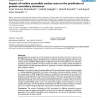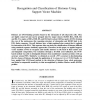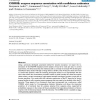151 search results - page 25 / 31 » Classifying protein sequences using hydropathy blocks |
BMCBI
2008
13 years 7 months ago
2008
Background: The problem of accurate prediction of protein secondary structure continues to be one of the challenging problems in Bioinformatics. It has been previously suggested t...
JCB
2006
13 years 7 months ago
2006
Histones are DNA-binding proteins found in the chromatin of all eukaryotic cells. They are highly conserved and can be grouped into five major classes: H1/H5, H2A, H2B, H3, and H4...
ICIP
2004
IEEE
14 years 9 months ago
2004
IEEE
In this proposal a novel implementation to find and recognize person actions in image sequences of meeting scenarios is introduced. Such extracted information can be used as the b...
BMCBI
2005
13 years 7 months ago
2005
Background: Structural and functional research often requires the computation of sets of protein structures based on certain properties of the proteins, such as sequence features,...
BMCBI
2007
13 years 7 months ago
2007
Using a previously developed automated method for enzyme annotation, we report the reannotation of the ENZYME database and the analysis of local error rates per class. In control ...



